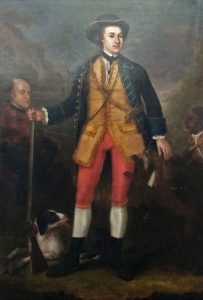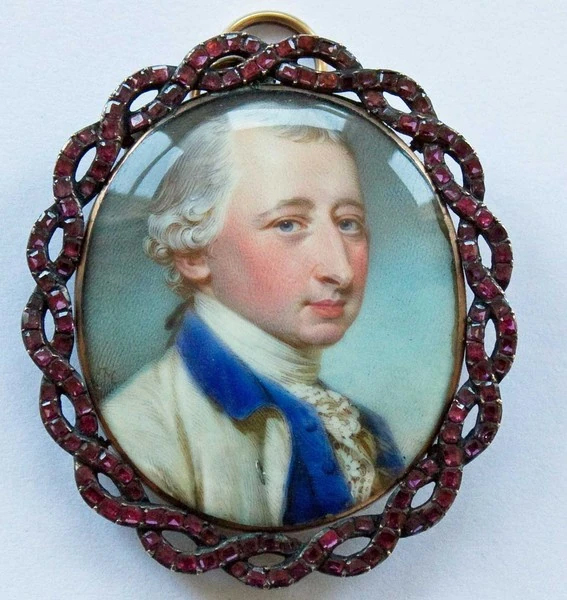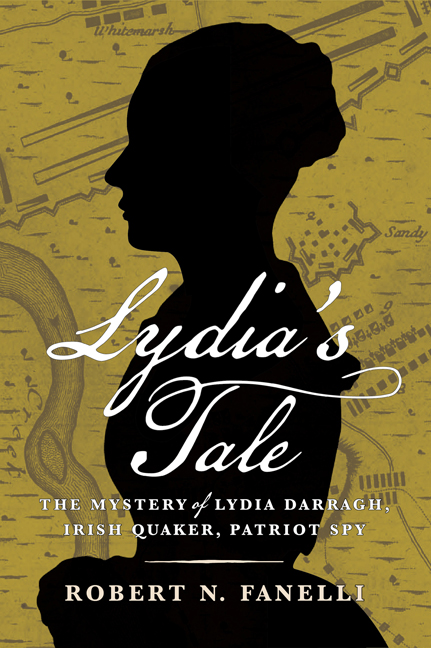
The battles of and between English born merchant Loyalist partisan Thomas Brown and illiterate native North Carolina American guerilla Elijah Clarke lacks for nothing, including drama. These two men fought each other more than once in a clash of their very different respective cultures/politics in Georgia and Florida. They fought many other battles at the risk of their respective lives and survived wounds that would have killed other men, one of the many things that these two mortal enemies have in common. Mysteries remain that those two men also share, including what they looked like. More has appeared in print on Brown than on any other Georgian of the Revolutionary War era or on any Loyalist partisan, including one full-length biography, two masters thesis, and numerous articles. This mountain of research turned up no likeness of him. Daniel Battle, researching for an upcoming archaeological survey of the Brier Creek Revolutionary War battle (March 3, 1779), however, discovered a November 2012 catalog that announced an auction of a portrait of Thomas Brown, Tory Revolutionary War partisan, painted by Archibald McLaughlin in 1766. It belonged to Lambuth University of Jackson, Tennessee.
The painting has much to support it as the likeness of the prominent southern Loyalist. Thomas Brown (born Whitby, Yorkshire, England, May 27, 1750) founded a settlement of indentured servants from the Orkney Islands of Scotland on the then western frontier of Georgia, in today’s Columbia County, in 1775.
An outspoken supporter of the King’s Cause, Thomas Brown faced an angry mob outside of his home in Augusta, Georgia, on August 2. The crowd beat him before tying him to a tree and setting his feet on fire. They also scalped him and applied a coat of tar and feathers. He lost two toes and had to wear a bandanna over his fractured skull. Headaches tortured “Burnt foot Brown” for the rest of his life and likely caused his addiction to laudanum.
Thomas Brown survived his injuries but Georgia authorities ordered him exiled and he removed to the neighboring colony of British East Florida. He formed a colonial battalion of escaped slaves, Indians, and white men with experience living with and as if Indians. They raided the southern counties of Georgia for cattle to feed Florida’s starving and growing population of Loyalist refugees, black and white. The Florida Scout also helped in the capture of forts Howe and McIntosh and became so bold that they rode through the streets of Augusta and Savannah. During the battle of Alligator Bridge, Florida, on June 30, 1778, Lieutenant Colonel Elijah Clarke of the Georgia state Minutemen took severe wounds leading troops in an unsuccessful attack against a position held by the rangers under Brown.
As the Carolina King’s Rangers, Brown’s battalion became a formal American provincial unit in the British army and accompanied the Florida wing of the December 1778 invasion of Georgia. The King’s army came to Georgia to restore the province to the crown as an experiment in starting a counter-revolution that would bring each colony back, one by one, to the Crown. The state of Georgia tried to rally resistance at the battle of the Burke County Jail. On January 26, 1779, Brown led an assault of his rangers and the restored colonial militia against the state militia there. Both sides took heavy casualties and Brown fell wounded and had to withdraw. He later had the jail buildings burned in revenge. The Georgia plan finally succeeded only after Charleston, South Carolina, fell to the King’s forces on May 12, 1780. Brown and his ranger battalion occupied Augusta within days and he became the British Indian superintendent for the southern colonies. Almost all of the Georgia state militia surrendered.

Elijah Clarke, by then a lieutenant colonel in the Wilkes County, Georgia militia, refused to give up and, with a small number of like-minded men, won a number of battles in South Carolina against the King’s forces. In September 1780, he pulled together some four-hundred men, some forced along under threats, and attacked the garrison and a party of Indians in Augusta. Brown again received serious wounds but he and his remaining men held out in an Indian trading post for four days under abominable conditions until help arrived from Ninety Six, South Carolina, under Lt. Col. John Harris Cruger. Clarke and his men withdrew to Wilkes County from where he led four hundred to seven hundred men, women, and children in a freezing starving wintery ten-day trek to today’s Tennessee to escape the retaliation from Cruger’s provincials and Indians. British Major Patrick Ferguson and the men of his American Provincial Corps attempted to intercept Clarke’ band but instead they were themselves caught and thoroughly defeated by militia from today’s western North Carolina and eastern Tennessee at the battle of King’s Mountain on October 9, 1780. Thomas Brown was in command at Fort Cornwallis at Augusta until he surrendered on June 5, 1781 to American forces partly commanded by Elijah Clarke. Brown and his men received escort for their safety to the British garrison at Savannah and subsequently transferred back to East Florida.[1]
This career supports Thomas Brown as the subject of Lambuth University’s painting. In the center stands a male figure with a gun, dead grey partridges (Perdix perdix) not yet in America, and hunting dogs. He could represent a Thomas Brown as a young man before he left for America.[2] To the figure’s right sits an old man with a gun. He resembles the young man standing in the center. The seated man has a bald head and scars across his forehead, as Brown would have had from his torture in 1775. A black boy peaks out at the viewer from the left of the figure in the center, quite likely an addition to the original painting. Thomas Brown apparently had a son George, whom he thought well of, by his slave Black Betty. He left her property in his will[3]

An examination of the back of the painting by Andy Golden of Golden & Associates of Charleston, however, revealed writing that reads “Thomas Broun of Braid Esqr. 1766 Archd. McLaughlin Panx. Academy Glasgow.” This refers to Thomas Broun of Braid and Johnstounburn in Scotland. Broun (d. July 7, 1818) married Agnes Hamilton on July 7, 1818.[4] A Glasgow gallery recently displayed Archibald McLauchlan’s painting of her and the Broun’s daughter dated 1766. McLauchlan did not write the words on the back of the painting unless he misspelled his own name. The painting from Lambuth University bears little resemblance to his other known works. He did work in the right time and place to have painted the central figure in 1766 in Northern England with Thomas Brown, then sixteen, as the subject. Sometime in the past, even before it turned up at Lambuth University, an art appraiser could have rightly identified the artist, although misspelling his name, but made an error in believing it to be the companion to the well-known painting of Broun’s wife Agnes and daughter.[5]
The university had no other information on the painting except that a German student bought the work in Boston and donated it to the college. Joan Leggett, a descendant of the Loyalist Thomas Brown, engaged in a search to learn as much as she could about the painting but discovered a conflicted and bizarre history of its appraisals. She learned that Dr. William C. McAfee, a professor at Lambuth University, had actually donated the painting to the college in 1980. An appraiser described it as a painting of “Archduke McGloghlin with Hounds and Gamekeeper” by artist Thomas A. Brown mounted in a Twentieth Century frame. Thirty-one years later, a description in another catalog referred to it as a 1776 painting of Thomas Brown, Esqr., by artist William McCullough of the Glasgow Academy.[6]

Period art expert James Kochan, however, examined photographs of the painting and came to a different opinion. He identifies the male in the center of the painting as around age thirty and therefore likely Thomas Broun of Braid, member of the Gentry. The clothing on all three figures he finds consistent with the mid-1760s. He suggests an identification of that older man seated to the right of the central figure as a servant with either a paint defect on his forehead or a brand, such as “H” for horse thief. Southern cultures expert Dale Couch has seen black servant boys in identical positions appear in other paintings of the era. The final answer may only come if or when x-rays and ultra violet examinations show if the painting began as only the image of young man but cultural experts see nothing inconsistent with the inscription on the back of the painting.
Ironically, the surviving images of Elijah Clarke (born in Anson County, North Carolina, in 1742) have their own controversies as discovered in research by Clarke descendents Louise Thoman and the late Robert Wilson.[7] Unlike the life of Thomas Brown, no one has written a credible full biography of Elijah Clarke, only poorly researched novels. The pioneer historian of the Revolutionary War South, Lyman C. Draper contacted Clarke descendants in an only partially successful effort to learn more about the Patriot partisan leader. They included in their replies what they knew about his likeness. Two nearly identical portraits, widely published, came from a miniature made of him after the American Revolution. His descendents did not consider the miniature a good likeness at the time although others liked the portraits made from it or photographs made from it. A more sophisticated painting of him turned up with descendants in Tryon County, North Carolina and today hangs on display at the Augusta Museum of History. One theory has the famous American artist Rembrandt Peale creating it from one of the earlier paintings made from the miniature. Peale had a reputation for new renderings of his famous father Charles Willson Peale’s portraits.[8]
Brown and Clarke both received large tracts of land from their respective governments but each also had a difficult post war life. Elijah Clarke died in Augusta on December 5, 1799 while trying to settle his considerable debts. His controversial ambitions on the Georgia-Florida frontier overshadowed his extensive public service. At one point, he even claimed that Brown had returned and was inciting the Indians.[9] During the War of 1812, Thomas Brown did write to the British government of his work with the Indians during the American Revolution and that he could still serve the King in that manner. He also had heavy debts and he spent two years in an English prison for forgery before his death at his plantation home in St. Vincent Island on August 3, 1825.[10]
[1] For the career of and publications about Thomas Brown see Edward J. Cashin, The King’s Ranger: Thomas Brown and the American Revolution on the Southern Frontier (Athens, Ga., 1989).
[7] See the Robert Stephens Wilson Collection, Ms2625, Hargrett Rare Book and Manuscript Library, University of Georgia Libraries, Athens.
[8] John A. Campbell to Lyman C. Draper, July 9, 1887, Ann Campbell to Draper, April 22, 1872, E. M. Hobson to Lyman C. Draper, October 8 and 23, 1872, letters 15, 16, 18, Georgia, Alabama, and South Carolina Papers (series V), Lyman C. Draper Collection, State Historical Society of Wisconsin, Madison; Louise Thomas to author, September 17, 2011, in the author’s possession.
[9] Edwin Bridges, “To Establish a Separate and Independent Government,” Furman Review 5 (1974): 11-17; Louise F. Hays, “Chronology of Georgia, 1773-1800,” typescript, Georgia Archives; and Richard K. Murdoch, “Elijah Clarke and the Anglo-American Designs on East Florida,” Georgia Historical Quarterly 35 (1951): 174-90. For Elijah Clarke’s many battles, wounds, and illnesses during the Revolution see volume one Gordon B. Smith, Morningstars of Liberty: The Revolutionary War in Georgia, 2 vols. (Milledgeville, Ga., 2006, 2013).








One thought on “Portraits of Southern Partisans: Likenesses of Thomas Brown and Elijah Clarke”
These are extraordinary images of actual soldiers of the Revolution published several years ago and, if you have not seen them, they are worth looking at.
Check out: http://www.dailymail.co.uk/news/article-2356524/Faces-American-revolution-Amazing-early-photographs-document-heroes-War-Independence-later-years.html